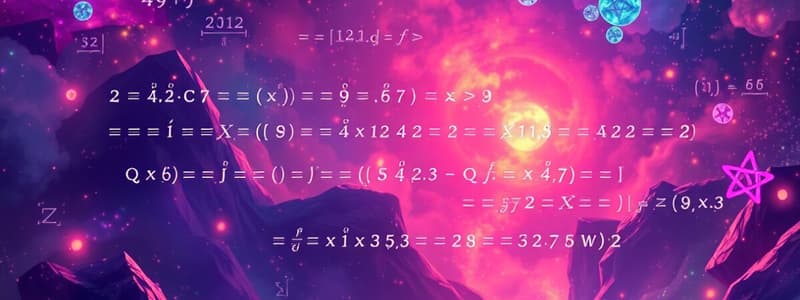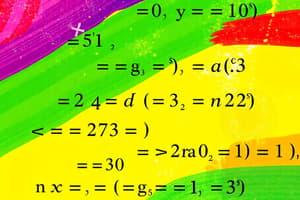Podcast
Questions and Answers
Which of the following expressions demonstrates the correct application of the distributive property?
Which of the following expressions demonstrates the correct application of the distributive property?
- $5(y - 2) = 5y - 10$ (correct)
- $3(a + b) = 3 + a + b$
- $2(x + 3) = 2x + 3$
- $-(z - 4) = -z - 4$
Given the equation $3x + 5 = 14$, what algebraic property is used to isolate x?
Given the equation $3x + 5 = 14$, what algebraic property is used to isolate x?
- Associative property
- Addition property of equality (correct)
- Commutative property
- Multiplication property of equality
Simplify the following expression by combining like terms: $4x^2 + 3x - 2x^2 + x - 5$.
Simplify the following expression by combining like terms: $4x^2 + 3x - 2x^2 + x - 5$.
- $5x - 5$
- $2x^2 + 4x - 5$ (correct)
- $7x^2 + 4x - 5$
- $2x^4 + 4x^2 - 5$
Which of the following is a binomial expression?
Which of the following is a binomial expression?
Solve the following inequality: $2x + 3 < 7$.
Solve the following inequality: $2x + 3 < 7$.
What is the coefficient of the x term in the expression $5x^2 - 3x + 7$?
What is the coefficient of the x term in the expression $5x^2 - 3x + 7$?
Which of the following is an example of an equation?
Which of the following is an example of an equation?
What is the solution to the system of equations: $y = x + 1$ and $y = 2x - 3$?
What is the solution to the system of equations: $y = x + 1$ and $y = 2x - 3$?
What is the slope-intercept form of a linear equation?
What is the slope-intercept form of a linear equation?
If you multiply or divide both sides of an inequality by a negative number, what must you do?
If you multiply or divide both sides of an inequality by a negative number, what must you do?
Flashcards
What is Algebra?
What is Algebra?
A branch of mathematics using symbols to represent numbers and quantities, solving equations and inequalities to find unknown variables.
What is a Variable?
What is a Variable?
A symbol, usually a letter, representing a quantity that can change or vary.
What is a Constant?
What is a Constant?
A fixed value that does not change, usually a number.
What is an Expression?
What is an Expression?
Signup and view all the flashcards
What is an Equation?
What is an Equation?
Signup and view all the flashcards
What are Inequalities?
What are Inequalities?
Signup and view all the flashcards
What is a Term?
What is a Term?
Signup and view all the flashcards
What is a Coefficient?
What is a Coefficient?
Signup and view all the flashcards
What are Like Terms?
What are Like Terms?
Signup and view all the flashcards
What is a Polynomial?
What is a Polynomial?
Signup and view all the flashcards
Study Notes
- Algebra is a branch of mathematics that uses symbols to represent numbers and quantities
- It involves solving equations and inequalities to find the values of unknown variables
Variables
- A variable is a symbol, usually a letter, that represents a quantity that can change or vary
- Common variables include x, y, z, a, b, and c
- Variables can represent unknown values that we want to find or quantities that can take on different values in a given problem
Constants
- A constant is a fixed value that does not change
- Constants are usually numbers, such as 2, -5, 3.14 (pi), or e (Euler's number)
- In an algebraic expression or equation, constants remain the same regardless of the values of the variables
Expressions
- An algebraic expression is a combination of variables, constants, and mathematical operations such as addition, subtraction, multiplication, and division
- Examples of algebraic expressions: 3x + 2, y^2 - 5, 2ab + c
- Expressions do not contain an equals sign (=)
Equations
- An equation is a statement that two algebraic expressions are equal
- Equations contain an equals sign (=)
- Examples of equations: 2x + 3 = 7, y - 5 = 10, x^2 + 2x + 1 = 0
- The goal of solving an equation is to find the value(s) of the variable(s) that make the equation true
Inequalities
- An inequality is a statement that compares two algebraic expressions using inequality symbols
- Common inequality symbols:
- < (less than)
-
(greater than)
- ≤ (less than or equal to)
- ≥ (greater than or equal to)
- ≠ (not equal to)
- Examples of inequalities: x + 2 < 5, 2y - 1 ≥ 3, a ≠ 4
- Solving an inequality involves finding the range of values for the variable(s) that satisfy the inequality
Operations
- Basic operations in algebra:
- Addition (+)
- Subtraction (-)
- Multiplication (× or *)
- Division (÷ or /)
- Exponentiation (^)
- Root extraction (√)
- Order of operations: Parentheses, Exponents, Multiplication and Division, Addition and Subtraction (PEMDAS)
Terms
- A term is a single number, a variable, or a product of numbers and variables
- Terms are separated by addition or subtraction signs in an algebraic expression
- Examples of terms: 3x, -2y^2, 5, ab, -c/4
Coefficients
- A coefficient is the numerical factor of a term that contains a variable
- It is the number that is multiplied by the variable in a term
- Examples:
- In the term 3x, the coefficient is 3
- In the term -2y^2, the coefficient is -2
- In the term ab, the coefficient is 1 (since ab is the same as 1*ab)
Like Terms
- Like terms are terms that have the same variable(s) raised to the same power(s)
- Like terms can be combined by adding or subtracting their coefficients
- Examples of like terms:
- 3x and 5x (both have the variable x raised to the power of 1)
- 2y^2 and -4y^2 (both have the variable y raised to the power of 2)
- 7ab and -ab (both have the variables a and b raised to the power of 1)
- Unlike terms cannot be combined
Polynomials
- A polynomial is an algebraic expression consisting of one or more terms, where each term contains only non-negative integer exponents
- Examples of polynomials:
- 5x^2 - 3x + 2 (quadratic polynomial)
- 2x^3 + x - 7 (cubic polynomial)
- 4 (constant polynomial)
- Polynomials can be classified based on the number of terms:
- Monomial: A polynomial with one term (e.g., 3x^2)
- Binomial: A polynomial with two terms (e.g., 2x + 1)
- Trinomial: A polynomial with three terms (e.g., x^2 - 5x + 6)
Simplifying Expressions
- Combining like terms: Add or subtract the coefficients of like terms to simplify an expression
- Distributive property: Multiply a term by each term inside parentheses
- Factoring: Expressing a polynomial as a product of simpler polynomials or terms
Solving Equations
- Isolate the variable: Use algebraic operations to isolate the variable on one side of the equation
- Addition and subtraction property of equality: Adding or subtracting the same quantity from both sides of an equation does not change the equality
- Multiplication and division property of equality: Multiplying or dividing both sides of an equation by the same non-zero quantity does not change the equality
- Solving linear equations: Use algebraic operations to isolate the variable and find its value
- Solving quadratic equations: Use factoring, completing the square, or the quadratic formula to find the solutions
Solving Inequalities
- Similar to solving equations, but with some differences
- When multiplying or dividing both sides of an inequality by a negative number, the direction of the inequality sign must be reversed
- Express the solution as a range of values for the variable
Graphing Linear Equations
- Linear equations can be represented graphically as straight lines on a coordinate plane
- Slope-intercept form: y = mx + b, where m is the slope and b is the y-intercept
- Point-slope form: y - y1 = m(x - x1), where m is the slope and (x1, y1) is a point on the line
- Use the slope and y-intercept or two points on the line to graph the equation
Systems of Equations
- A system of equations is a set of two or more equations containing the same variables
- The solution to a system of equations is the set of values for the variables that satisfy all equations in the system
- Methods for solving systems of equations:
- Substitution
- Elimination
- Graphing
Studying That Suits You
Use AI to generate personalized quizzes and flashcards to suit your learning preferences.




